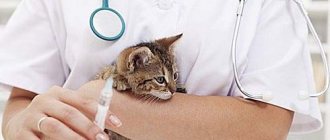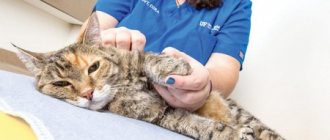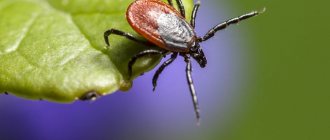A cat is not only a source of affection and relief from a bad mood in a natural way, without taking any herbs or pills. This relative of wild predators, especially at a young age, through his bite or scratch can transmit felinosis - cat scratch disease. This disease has a long course, accompanied by inflammation and sometimes suppuration of the lymph nodes near the scratched area. If at the time of infection the person’s immunity was not suppressed by the disease or medications, the disease passes without complications. Otherwise, complications from the liver, brain and spleen may occur.
About the causative agent of the disease
Felinosis is caused by a very unusual bacterium - Bartonella henselae. This is an intermediate form between a bacterium and a virus: in shape it does not differ from a bacterium and even has a flagellum; destroyed by antibiotics. But, like a virus, it lives inside a cell and is grown not on nutrient media, but on living cells. Its “cousins,” Rickettsia, are the causative agents of many diseases, including typhus, a pathology that appears in some people who have lice on their heads.
The name of the disease, felinosis, comes from the word “Felis,” which is the Latin name for cats. The “name” of the bacterium – Bartonella hensele – was given to it in honor of the microbiologist who discovered the microbe and described its properties, Diana Hensel.
Types of wounds in dogs
Depending on the characteristics of the object causing the wound, wounds are classified into nine types.
Table 1. Types of wounds in dogs
| Type of wound | Description |
| Scratches with abrasions | They arise as a result of a dog touching an object or plant while trying to vigorously scratch a certain area of the body. Some animals injure themselves by biting fleas or trying to get rid of mats and pieces of matted fur. |
| Cuts | Appear on the pet's body upon contact with various objects with sharp edges. It happens, for example, that the tissues of the mouth are injured by the broken ends of chewed bones |
| Severe bites from other animals | Wounds of this nature are most often subject to inflammatory processes. This is due to the fact that from the very beginning the surface of the damaged area of the body is contaminated with substances released from the aggressor’s mouth |
| Splinters | These foreign particles usually get into the paw when the dog is running outside. However, sometimes they have to be removed even from the tissues of the cheeks or tongue, because these pets love to chew wooden pieces of furniture |
| Injuries resulting from an accident | According to experts, it is in these cases that animals receive the most complex injuries, which may even be incompatible with life. |
| Puncture wounds | Damage occurs due to contact with a sharp object that can quite easily pass through living tissue. Depending on the nature of the damaging product, wound channels can be smooth or rough |
| Chopped wounds | They are a type of injury characterized by serious destruction of fairly deep tissues, as well as damage to the walls of lymphatic and blood vessels, and lacerated nerves. In many animals, joints and other bone elements are crushed |
| Bruised wounds | They occur after the dog’s body is exposed to blunt objects. In this case, as a rule, multiplication and crushing of not only the epidermis, but also deeper muscles occurs. In addition, minor blood loss occurs |
| Lacerations | Applied with a pointed object. For pets, they are dangerous due to rupture of tendons and ligaments, as well as various infections entering the body. |
It happens that dogs receive combined wounds. Moreover, each injury is accompanied by the risk of infection. After all, dirt and dust, fluff and hair, rust and foreign bodies penetrate inside damaged skin along with foreign objects. Therefore, even a small wound must be treated with an antiseptic.
There are special antiseptics for dogs
It should be noted that you should treat yourself at home only those wounds that are superficial and do not pose the slightest danger to the life of your pet.
How and from whom do they get infected?
The bulk of Bartonella “lives” in the body of domestic and wild cats. The bacterium is transmitted to each other by cat fleas, in whose intestines the microbe lives for up to 9 days. These insects are not dangerous to humans.
According to statistics, almost half of cats have this pathogen in their blood, and the animals do not experience any symptoms of the disease, although they have been sick for several years. There is even an opinion that this bacterium normally inhabits the mouth of cats. They excrete the bacterium in their urine and saliva, from where it ends up on the cats' paws.
Therefore, you can become infected:
- when bitten by an animal;
- through damage from a cat's claw;
- through contact with saliva in the eye (on the conjunctiva) or on damaged skin;
- if the water/food that the cat drank came into contact with mucous membranes or injured skin;
- if there is an injection with a fishing hook, a splinter or thorns of plants on which the cat’s saliva has come into contact.
The most dangerous in terms of contagiousness are kittens that are not yet 1 year old. Adult cats are slightly less dangerous. But dogs, monkeys, and rodents can also become a source of infection. You can even become infected by pricking yourself with a hedgehog needle or a bird feather.
Usually affected:
- hands;
- skin of legs;
- head;
- face;
- neck;
- rarely - eyes.
A person cannot infect a person. And someone who has had felinosis once will not develop the disease again. 5% of people are immune to felinosis (of which 25% are owners of domestic cats).
Prevention
If you receive scratches or bites, you should let the blood (possibly infected) drain a little, then wash the wound with running water and laundry soap and treat with hydrogen peroxide or chlorhexidine. If necessary, apply a gauze bandage. Just a little bit - immediately see a doctor!
Protecting yourself from BCC means minimizing the risk of being bitten or scratched by a cat:
- play with your pet until its claws come out. Communicate with kittens in clothing that covers your arms and legs.
- do not approach the cat when it is in an excited state. Do not tease her, do not touch her while eating, etc.
- Do not pet or pick up unfamiliar (especially stray!) cats.
- and, as always, wash your hands after handling your cat.
What increases the chance of a more severe course of felinosis
A person who has come into contact with Bartonella hensele develops a severe or even atypical form of felinosis in the following situations:
- there is a congenital pathology of the cellular immune system;
- after a serious illness or surgery;
- when you need to take glucocorticoids (for the treatment of autoimmune diseases such as rheumatoid arthritis, autoimmune hepatitis, psoriasis, and so on);
- after treatment with cytostatic drugs (cyclophosphamide, cyclosporine, azathioprine);
- in persons who abuse alcohol;
- in patients with diabetes mellitus;
- in HIV-infected people.
In the latter case, felinosis is very severe and long-lasting; sometimes its manifestations are so atypical that they don’t even think about this diagnosis.
Purulent processes and recommended antibiotics
Often purulent processes begin to develop in the wound canal, which are accompanied by the formation of exudate and the manifestation of characteristic symptoms:
- A sharp increase in body temperature;
- Apathy;
- Weakness;
- Lack of appetite.
Indifference to food and apathetic mood indicate a deterioration in the dog’s condition
To eliminate undesirable consequences, the veterinarian must select suitable antibacterial medications that will help quickly cope with inflammation and suppuration of the injury. Effective and widely used drugs are:
- Cephalosporins - Cephalen, Cephalex, and Cefotaxime;
- Penicillins - “Sinulox”, “Ampicillin” and “Amoxicillin”;
- Tetracyclines – “Doxycycline”.
Broad spectrum antibiotics can be found in every pharmacy at an affordable price
As a rule, the course of therapy lasts no longer than two weeks. It should be noted that it is forbidden to apply sutures to wounds complicated by infectious microflora
How does the disease manifest itself?
A scratch or site of a cat bite heals slowly for the first 3-10 days, without causing any concern on the part of the person: it may hurt a little or irritate, like a regular skin injury. This is the incubation period; At this time, the pathogen overcomes the barriers of the integumentary tissue and multiplies. This period can extend up to 3 weeks, then at the time the first symptoms of felinosis appear, skin trauma no longer exists.
After the time it takes for the microbe to penetrate and accumulate (3 days to 3 weeks, on average 7-14 days), a rash appears in the place where there was a scratch or where a crust remains. It looks like several nodules the size of a millet grain to a pea, which do not itch or hurt.
After 2-3 days, the period of the height of the disease begins: such nodules fester and open up on their own, after which they become covered with a crust and may begin to itch slightly (especially if a child with allergies has been scratched). Within 1-3 weeks, the crusts dry and fall off, after which the bite site ceases to be noticeable: there are no scars or darker areas of skin left. This means that Bartonella has multiplied in sufficient quantities, overcome the local immunity of the skin area and entered the lymphatic system.
After 10-14 days (less often - longer) from the moment the first nodules appear, the microbe is caught by regional lymph nodes - local filters that try to prevent it from passing further.
If the arm below the elbow was bitten, one or more groups of lymph nodes enlarge: elbow, axillary, cervical. The order in which lymphadenitis appears may be exactly this, but the axillary nodes may immediately enlarge, while the ulnar nodes remain unchanged. Also, starting from the axillary fossa, the lymph nodes will enlarge if the forearm or shoulder is damaged by claws or teeth.
If the bite/scratch is on the leg, the lymph nodes in the femoral and groin area become inflamed. When the face is scratched, the submandibular, anterior or posterior ear groups may be the first to react; after which one or more lymph nodes from the cervical group enlarge.
Signs that indicate that the lymph nodes are damaged due to felinosis:
- lymph nodes gradually increase, reaching from 5 to 10 cm in diameter;
- they are dense;
- it hurts to feel them;
- the skin over them is not red or hot to the touch;
- lymph nodes can be moved - they do not pull the skin along with them;
- when enlarging the entire group of nodes, probing them, you can “roll” them independently of each other: they are not soldered together.
Enlarged lymph nodes are accompanied by a deterioration in the person’s general condition. The following symptoms appear:
- fever, sometimes up to 39°C or higher;
- headache;
- malaise;
- weakness;
- poor sleep;
- sweating;
- loss of appetite;
- heartbeat.
Not everyone’s temperature rises to such high numbers: in some cases, it may be completely absent. The increase in temperature lasts from a week to a month, other symptoms gradually disappear within 2 weeks. Lymph nodes remain enlarged for up to three months. In half of the cases, they suppurate and can spontaneously open: then thick yellow-green pus is released to the surface, which, when taken for bacteriological examination, does not show signs of bacterial infection (as you remember, Bartonella does not grow on nutrient media).
During the same period, a reddish rash may appear on the skin of a person’s body or limbs, occupying larger or smaller areas of the skin. It does not itch or hurt and disappears after a few days.
During the period of lymph node enlargement, the following may also be observed:
- discomfort and pain in the right hypochondrium - this is an enlargement of the liver, which is also a filter on the way of Bartonella, which by this time has entered the blood;
- a feeling of “needles” or discomfort in the left hypochondrium: this may indicate an enlarged spleen, which can also be affected by felinosis. Enlargement of the liver and spleen can also be detected on an ultrasound scan of the abdominal cavity, without being accompanied by any symptoms;
- heart pain, arrhythmias. These are signs of heart damage;
- enlargement of lymph nodes located far from the site of infection.
The above symptoms of cat scratch disease occur in people whose immunity is not active enough and allows the infection to enter the blood. In those people who are called “immunocompromised” (who have received drugs that suppress the immune system, suffer from diabetes mellitus, congenital immunodeficiency, HIV, chronic alcoholism), felinosis proceeds completely atypically. In them, the infection can remain in the body forever, causing chronic disease.
Usually the disease ends a month or a little less after the first lymph node enlarges: the temperature drops, the headache goes away, sleep and appetite are restored, the lymph nodes gradually decrease in size and become dense little “balls” that are not fused to each other and the skin. Very rarely, with moderately weak immunity, felinosis can last 1-2 years, when its symptoms either subside or reappear.
Atypical forms of the disease
This term is called:
- a disease that occurs in response to a microbe entering a place other than the skin (for example, the conjunctiva of the eye);
- Bartonellosis organ damage, characteristic only of people with “compromised” immunity.
Atypical forms are not complications of felinosis; they are a severe, atypical current infection.
Eye damage
If a cat's saliva gets on the conjunctiva of the eye, it may develop:
- Conjunctivitis Parilo. In this case, only one eye is affected. It is red, swollen, and difficult to open. It doesn’t hurt, and nothing comes out of it. Upon examination, the ophthalmologist will see nodules and ulcers on the conjunctiva.
Simultaneously with the damage to the eye, the parotid lymph nodes on the same side become inflamed. The anterior auricular node is always affected: it grows to 5 cm or more, can suppurate and open, after which a scar forms. The submandibular and cervical lymph nodes may also enlarge. At the same time, the general condition worsens: weakness, palpitations appear, body temperature rises, and sleep deteriorates.
- Neuroretinitis. At the same time, vision in one eye deteriorates. The state of health has not changed. Changes characteristic of felinosis are seen by an ophthalmologist during examination.
Damage to the nervous system
When Bartonella gets into the blood, 2-3 weeks after inflammation of the regional lymph nodes, signs of damage to the nervous system may appear. This includes a decrease in sensitivity only in the area of socks and gloves, or spreading higher, a violation of the motor function of one or more limbs, trembling, and a lack of coordination.
Felinosis can also cause convulsions, inappropriate behavior, impaired consciousness, and paralysis of the facial nerve.
Atypical forms of immune deficiency
In people whose immunity is greatly reduced, felinosis occurs as bacillary angiomatosis or peliosis hepatitis.
Bacillary angiomatosis
This is the name of the pathology (it often develops only in HIV-infected people), when in response to the presence of bacteria of the genus Bartonella, vascular proliferation occurs.
Here, after damage by a cat's claw or teeth, an incubation period of several weeks or even months passes, that is, the wound heals. Cutaneous manifestations of the disease appear not in the place where the cat scratched, but in a random location. The mucous membranes of the mouth, genitals, and larynx are also affected.
The disease begins with the appearance of not small red nodules on the skin, but red or purple spots that do not protrude above it. Nodules appear later, against the background of these spots. Moreover, the nodes are not small, but large, up to 3 cm in diameter, painful, covered with red, inflamed skin. There may be several of them, individual ones, but there may be hundreds. Around each of them is a thin, eroded (reddish and oozing) epidermis.
The disease is accompanied by malaise, fever, and weight loss. Other organs may be affected: liver, spleen, heart, central nervous system, muscles, bone marrow.
Bacillary angiomatosis occurs in different ways: it can go away on its own, but can, with severe damage to internal organs, lead to death.
Peliosis hepatitis
In this case, cavities filled with blood form in the liver, causing the liver tissue to take on the appearance of a sponge. Symptoms of liver damage due to cat scratch disease:
- prolonged fever;
- chills occur periodically;
- the stomach feels “bloated”, which is due to the accumulation of gases in it;
- the skin takes on a pale yellow appearance;
- bleeding gums increases;
- areas of hemorrhage associated with damage to the blood coagulation system may appear on the skin.
Causes and risk factors
The causative agent of cat scratch disease is Rochalimaea henselae. Polymorphic non-motile gram-negative bacterium; is morphologically similar to representatives of the genus Rickettsia and exhibits similar properties to Afipia felis. A motile, non-fermenting, gram-negative rod-shaped bacterium. It is fastidious for in vitro cultivation, preferably grown on HeLa cells.
Risk factors for developing the disease:
- Disorders of cellular immune responses
- HIV infection, especially when the CD4+ lymphocyte count is below 100 in 1 μl
- Long-term use of GC, azathioprine, cyclophosphamide, cyclosporine, alcohol abuse.
Penetration of the pathogen through damaged skin or, less commonly, through the mucous membrane of the eye subsequently leads to the development of an inflammatory reaction in the form of a primary affect. Then, through the lymphatic ducts, the microbe enters the regional lymph nodes, which is accompanied by the occurrence of lymphadenitis. Morphological changes in the lymph nodes are characterized by reticulocellular hyperplasia, the formation of granulomas, and later microabscesses. The disease is usually accompanied by hematogenous dissemination with the involvement of other lymph nodes, liver, central nervous system, and myocardium in the pathological process. A severe and prolonged, and often atypical course of the disease is observed in patients with HIV infection.
Various mammals (cats, dogs, monkeys, etc.) are considered the reservoir and source of infection. The disease is registered everywhere. In regions with a temperate climate, an increase in incidence is noted from September to March. Considering the nature of the infection, the main contingent is persons under 21 years of age; 90% have a history of bites or scratches caused by kittens. Studies conducted on animals have shown that the microorganism does not cause the development of any pathology in them and they do not respond with the development of hypersensitivity reactions when the pathogen antigen is administered intradermally. Incidence: 10:100,000 population (25,000 cases annually).
Complications
When Bartonella, which causes felinosis, spreads through the blood to various internal organs, the following may occur:
- pleurisy;
- myocarditis;
- spleen abscess;
- osteomyelitis;
- arthritis;
- atypical pneumonia.
The bacterium can also cause significant blood complications, consisting of a decrease in various blood cells:
- platelets (thrombitopenic purpura);
- red blood cells (hemolytic anemia);
- eosinophilic leukocytes (eosinophilia);
- leukocytes (leukoclastic vasculitis).
What to do with open and deep wounds?
If your pet has received a deep wound, then, first of all, the surface must be washed and disinfected. Then antiseptic solutions are applied to the skin: Miramistin, Formalin or Chlorhexidine. However, you should not engage in further treatment on your own; it is better to consult a specialist to avoid any dangerous complications.
Self-medicating wounds in dogs is dangerous, since there is a high risk of germs entering and wound suppuration.
Diagnostics
An infectious disease specialist is involved in the treatment and diagnosis of felinosis. This specialist will distinguish cat scratch disease from wound suppuration by its appearance. So, if a cat scratches and the hand swells, this is most likely (although an inspection needs to be done) infection of the wound with ordinary (nonspecific) flora: strepto- or staphylococci, Proteas, maybe fungal flora. Such suppuration begins already on the second day after a scratch or bite, the site of injury is red, painful, a light liquid may be released from it, and later pus. With felinosis, the scratch heals, and against the background of a crust or even without it, nodules appear in this place that do not fester, do not hurt or itch.
“Bloating” of the hand after a bite or scratch is most likely a description of phlegmon (purulent melting of tissue) or, even worse, an anaerobic infection such as gas gangrene. Here you need urgent help from a surgeon, most likely with hospitalization.
If a person begins to be bothered by enlarged lymph nodes, a consultation with an infectious disease specialist is required. Best of all, not a doctor from a clinical hospital, but a doctor from the emergency department of an infectious diseases hospital. There is less chance of infecting other patients, because such manifestations, in the absence of nodules on the skin, must be distinguished from HIV infection, lymphogranulomatosis, infectious mononucleosis, as well as such dangerous diseases as plague and tularemia.
Having suspected felinosis based on the medical history (contact with a cat, the appearance of nodules), an infectious disease doctor will help confirm the diagnosis with the help of studies, for which he needs tissue material either from nodules, or from an abscess, or from a lymph node, for which the doctor must puncture the pathological element and take its contents for the following types of research:
- by polymerase chain reaction (PCR): this is how B.hanselae particles are detected and recognized. The analysis is performed by paid laboratories;
- histological: under a microscope, characteristic tissue changes, as well as bacteria, are visible.
Serological tests - the determination of antibodies to Bartonella - also help in diagnosis. To do this, reactions called either ELISA or RSK are performed.
At 3-4 weeks of illness, you can conduct a skin allergy test by injecting a solution with Bartonella particles under the skin: in 90% of people with felinosis, the response will be redness and swelling in this place. This study has not been conducted in children.
A general blood test, in which the number of eosinophils is increased and the ESR is accelerated, does not confirm the diagnosis, but allows us to draw a conclusion about the severity of the disease. Determination of liver tests will help to find out whether the liver function is affected and to what extent, and an ultrasound of the abdominal cavity will reveal an enlargement of the liver and/or spleen, which will give reason to adjust the regime to semi-bed (the spleen is a delicate organ, its capsule can be damaged by severe human activity).
What it is?
In simple terms, cat scratch disease is an acute or chronic infectious disease that develops after being scratched or bitten by an infected cat. In medicine, this pathology has several other names: felinosis, benign lymphoreticulosis, Mollaret granuloma.
For the first time, felinosis was described independently by 2 scientists - R. Debre and P. Mollare - in the middle of the 20th century. At first it was believed that the disease was of a viral nature, but in 1963, scientists from Russia - V.I. Chervonskaya, A.Yu. Bekleshov and I.I. Terskikh - a pathogen was isolated, which turned out to be a bacterium of the rickettsia group - Rochalimaea henselae.
Treatment of the disease
Felinosis is treated as follows: medications are prescribed for systemic use, compresses, and surgical treatment can be used.
Typical uncomplicated lesions of the heart, liver, spleen, and nervous system can be treated at home. Other forms require hospitalization of the person.
Drug treatment
Appointed:
- Antibiotics: doxycycline, erythromycin, tetracycline, ofloxacin, gentamicin, clarithromycin. They are used in the form of tablets, and in case of eye damage, also in the form of eye drops.
- Anti-inflammatory and painkillers: ibuprofen, diclofenac, mefenamic acid.
- Antihistamines: cetrin, L-cet, zodak, erius and others.
- In severe cases, glucocorticoids may be prescribed: dexamethasone, prednisolone.
Compresses
It is recommended to apply compresses to the area of inflamed lymph nodes. Take 1 part dimethyl sulfoxide to 4 parts water, wet gauze with this mixture, apply it to the lymph node, put polyethylene on top, and then secure it with a bandage and insulate it with a warm cloth.
Physiotherapeutic methods
The area of inflamed lymph nodes is exposed to UHF and diathermy.
Surgery
If the affected lymph nodes are tense and painful, they are punctured for the purpose of drainage: this way the pressure in the node decreases, which helps in relieving the pain process.
Features of the treatment of lacerated and weeping wounds in dogs
After damage is caused, regardless of its severity, various pathogenic microorganisms immediately accumulate on the surface of the skin around the wound. If the injury is torn and affects the deep layers of tissue, then after a couple of days the dog experiences a progressive inflammatory process.
Weeping wound on a dog
An equally common cause that leads to inflammation is failure to follow the rules of asepsis or the use of inappropriate antiseptics when the integrity of the skin and soft tissues is damaged. In this case, exudate containing blood plasma and lymph, as well as leukocytes, lymphocytes and other products of the inflammatory process is released from the wound channel. This substance provides a favorable environment for the proliferation of pathogenic bacteria and microorganisms. As a result, the formation of a weeping injury is observed. The wound emits a specific smell. Many owners note apathy and depression in their pet.
Lacerated wound in a dog
Carrying out therapy in such a situation involves carefully removing all exudate and crusts formed on the surface of the damaged area. After this, it is necessary to treat the area with a disinfectant. If your dog experiences severe itching of the skin and pain, you should consult a veterinarian who will recommend the most appropriate analgesics and antihistamines. Usually, Tavegin or Suprastin is prescribed, the active ingredients of which slow down the synthesis of histamine-like substances, thereby reducing the amount of exudate accumulating inside the wound.
Erythromycin ointment also effectively acts on harmful microbes, healing the wound
To eliminate pathogenic microflora, it is necessary to cover the affected area with ointments that have an antibacterial effect. Effective are “Vishnevskaya ointment”, “Tetracycline ointment”, and “Levomikol”. In severe cases, the animal is additionally given broad-spectrum antibiotics.
In addition to ointments and antibiotics, special sprays that can be found in veterinary pharmacies promote wound healing. Below are some brands of such drugs.
Sprays for treating wounds in dogs
Cat scratch disease in children
Felinosis in children usually occurs in a typical form: a scratch from a cat's claw goes away, and nodules appear in its place, which suppurate and open. After this, 1 or several nearby lymph nodes enlarge. The disease lasts about a month and can go away even without treatment.
An atypical form can develop in an HIV-infected child, a child who has undergone chemotherapy or organ transplantation. In this case, it is impossible to predict which organ or system will be affected. Symptoms of atypical forms in children correspond to those described above.
Diagnostics in children is the same; punctate PCR is its main method.
Treatment is carried out with the drug Sumamed at a dose of 10 mg/kg per day. From 8 years of age, doxycycline or tetracycline can be used. Drugs such as ciprofloxacin or ofloxacin are allowed from 16-18 years of age.
Why are scratches from a cat dangerous?
Animals need claws not only for hunting and self-defense, but also for free movement through trees. They have a curved hook-shaped design that provides maximum grip on the surface. The peculiarity of the shape contributes to the accumulation of dirt, pathogenic microorganisms and particles of prey under the claws.
When a scratch is applied, an open wound with capillary bleeding is formed. Pathogenic microorganisms penetrate the general bloodstream and, with pathologically low immunity, can provoke the development of serious diseases.
Cat scratches can be very dangerous
The most dangerous disease that can be contracted from furry pets is felinosis. The disease is caused by chlamydia that enters through a small scratch on the skin. There is a long latent period, as well as debut in an acute form with damage to regional lymph nodes. If left untreated, it can cause advanced forms of lymphadenitis, as well as many other complications. Most often, children get sick because their immune system is not able to cope with chlamydia on its own.
Features of a dog's diet after injury
After receiving an injury, which leads to destruction of the integrity of the skin, soft tissues, bones, nerves, tendons, blood and lymphatic vessels, processes begin to occur in the animal’s body aimed at stopping inflammation and regenerating the damage. Therefore, the dog quickly loses strength.
To avoid dehydration due to blood loss, the dog must have constant access to water.
To restore them and support the immune system, it is very important to provide your pet with adequate nutrition, along with which his body will receive all the necessary vitamins and beneficial microelements. In addition, it is necessary that he has constant access to clean water, because the injury is accompanied by blood loss, which requires restoration of the water balance.










